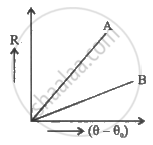Advertisements
Advertisements
Question
A body cools down from 65°C to 60°C in minutes. It will cool down from 60°C to 55°C in
Options
5 minutes
less than 5 minutes
more than 5 minutes
less than or more than 5 minutes depending on whether its mass is more than or less than 1 kg.
Solution
more than 5 minutes
Let the temperature of the surrounding be `T^circ C`Average temperature of the liquid in first case = `62.5^circ`
Average temperature difference from the surroundings = `(62.5 - T )^circ C`
From newton law of cooling,
1° C min-1 = -bA ( 62.5 - T )°C
`⇒ -bA = 1/(62.5 - t) "min"^-1 ` ...... ( i )
For the second case,
Average temperature = 57.5° C
Temperature difference from the surroundings = ( 57.5 - 7 )° C
From Newton's law of cooling and equation (i),
`(5^circ C)/ t = -bA ( 57.5 - T )^circ C`
`⇒ (5^circ C)/t = 1/(62.5 - t) (57.5 - T )^circ C`
`⇒ t = (5 ( 62.5 - T ))/ ((57.5 -T ))`
`⇒ t > 5 \text{minutes}`
APPEARS IN
RELATED QUESTIONS
A body cools from 80 °C to 50 °C in 5 minutes. Calculate the time it takes to cool from 60 °C to 30 °C. The temperature of the surroundings is 20 °C.
On a hot summer day we want to cool our room by opening the refrigerator door and closing all the windows and doors. Will the process work?
On a cold winter night you are asked to sit on a chair. Would you like to choose a metal chair or a wooden chair? Both are kept in the same lawn and are at the same temperature.
The temperature of the atmosphere at a high altitude is around 500°C. Yet an animal there would freeze to death and not boil. Explain.
Answer the following question.
State Newton’s law of cooling and explain how it can be experimentally verified.
Solve the following problem.
A metal sphere cools at the rate of 0.05 ºC/s when its temperature is 70 ºC and at the rate of 0.025 ºC/s when its temperature is 50 ºC. Determine the temperature of the surroundings and find the rate of cooling when the temperature of the metal sphere is 40 ºC.
A metal sphere cools from 80 °C to 60 °C in 6 min. How much time with it take to cool from 60 °C to 40 °C if the room temperature is 30 °C?
Rate of cooling of a body is 0.4 °C/min when excess temperature is 20 °C. The proportionality constant is ______.
A metal sphere cools from 66° C to 57° C in 10 minutes and to 44° C in the next 10 minutes. The ratio of fall of temperature of first 10 minutes to next ten minutes is ____________.
Newton's law of cooling leads to the expression:
A tub of hot water cools from 80°C to 75°C in time t1 from 75°C to 70°C in time t2, and from 70°C to 65°C in time t3 then:
Two circular discs A and B with equal radii are blackened. They are heated to the same temperature and are cooled under identical conditions. What inference do you draw from their cooling curves?

A cup of coffee cools from 90°C to 80°C in t minutes, when the room temperature is 20°C. The time taken for a similar cup of coffee to cool from 80°C to 60°C at a room temperature same at 20°C is ______
A cup of coffee cools from 90°C to 80°C in t minutes, when the room temperature is 20°C. The time taken by a similar cup of coffee to cool from 80°C to 60°C at a room temperature same at 20°C is ______.
A glass full of hot milk is poured on the table. It begins to cool gradually. Which of the following is correct?
- The rate of cooling is constant till milk attains the temperature of the surrounding.
- The temperature of milk falls off exponentially with time.
- While cooling, there is a flow of heat from milk to the surrounding as well as from surrounding to the milk but the net flow of heat is from milk to the surounding and that is why it cools.
- All three phenomenon, conduction, convection and radiation are responsible for the loss of heat from milk to the surroundings.
Is the bulb of a thermometer made of diathermic or adiabatic wall?
According to Newton's law of cooling, the rate of cooling of the body is proportional to (Δθ), where Δθ is the difference between the temperature of the body and the surroundings, and n is equal to ______.
In 5 minutes, a body cools from 75°C to 65°C at a room temperature of 25°C. The temperature of the body at the end of the next 5 minutes is ______°C.
